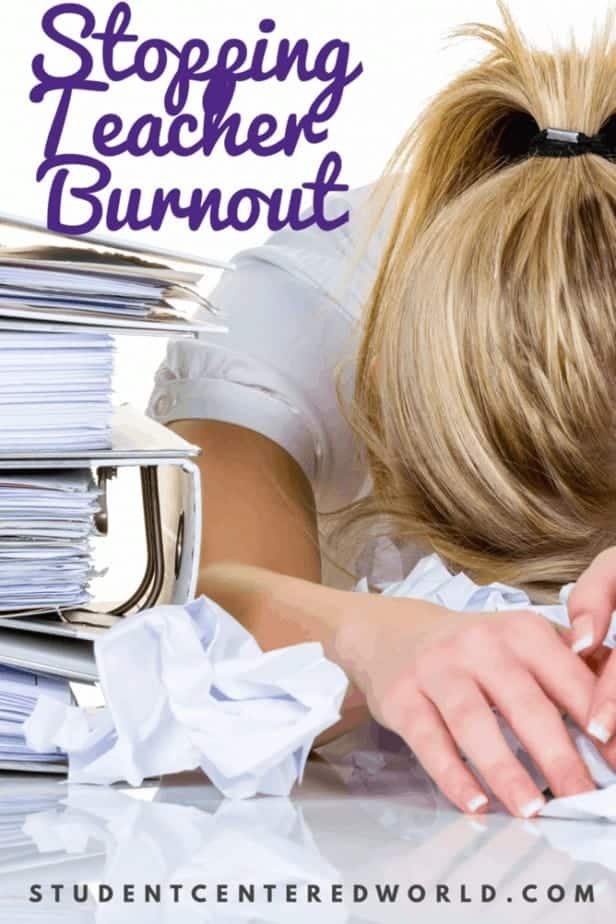How to Prevent Teacher Burnout and Avoid Symptoms of it
Since starting Student-Centered World, I’ve had the chance to speak with educators across the teaching profession—from new teachers to veteran teachers and school leaders. Teacher stress (or “teacher tired”) is a pervasive issue that affects everyone, no matter where they are in their careers. However, the primary concern given the current teaching climate, universally, is the fear of or onset of burnout.
Considering the physical, emotional, and psychological exhaustion teachers experience daily, it’s no surprise that burnout is a significant concern. The 2017 Educator Quality of Work Life Survey by the American Federation of Teachers revealed that 61 percent of teachers found their jobs always or often stressful—and that was before a global pandemic and the student apathy crisis.
Does this resonate with you?
This issue isn’t confined to the United States. While work environments vary globally, many school systems worldwide face similar challenges, including high-poverty schools, unreasonable class sizes, and demanding lesson plans. Educators globally are encountering the same symptoms of burnout.
There have been some efforts to study and address this issue on various levels, from individual initiatives to broader global strategies.
What does it truly mean to be burned out as a teacher?
The American Psychological Association’s “Psych Learning Curve” emphasizes that burnout is essentially work-induced depression. This significant connection underscores the importance of discussing mental health, particularly for teachers who are often at the forefront of this issue. Understanding and addressing mental health in the teaching profession is critical, as the impact of burnout extends beyond individual educators to the entire education system.
Burnout symptoms commonly mirror those of depression. These symptoms include:
- Fatigue: Teachers often feel physically and emotionally drained, making it difficult to maintain energy throughout the day. This persistent exhaustion is a clear sign of burnout and can significantly impact teaching effectiveness.
- Loss of interest in previously enjoyable activities: Educators may find that activities they once loved, both professionally and personally, no longer bring them joy. This loss of interest can lead to disengagement and a decrease in the quality of education provided to students.
- Mood swings: Irritability and fluctuating emotions are common among burned-out teachers. These mood swings can create a challenging classroom environment, affecting both teachers and students.
- Irritability: Increased irritability is a frequent symptom of burnout. Teachers may find themselves becoming easily frustrated with students, colleagues, and even their personal lives, leading to strained relationships and a negative work atmosphere.
- A general sense of malaise: A pervasive feeling of unease or dissatisfaction often accompanies burnout. This sense of malaise can make it difficult for teachers to find motivation and purpose in their work, further exacerbating the cycle of burnout.
Recognizing the desire for change is crucial in addressing teacher burnout. One key indicator of depression, and thus burnout, is the loss of joy in something once passionately pursued. For many educators, teaching is not just a job but a calling. When the passion for teaching diminishes, it signals a need for intervention.
Reigniting the passion for teaching is challenging but essential. Acknowledging the need for change is the first step. Teachers must reflect on their current state and identify the aspects of their jobs that contribute to their stress and dissatisfaction. This self-awareness is a powerful tool in combating burnout.
How to Address Burnout
One approach to addressing burnout is fostering a supportive work environment. School leaders and administrators play a vital role in this. By recognizing the signs of burnout and providing necessary support, they can help teachers navigate their challenges. This support might include professional development opportunities focused on stress management, access to mental health resources, and a culture that prioritizes teacher well-being.
Another critical aspect is encouraging teachers to set boundaries and prioritize self-care. Teachers should be empowered to take time for themselves, pursue activities they enjoy, and maintain a healthy work-life balance. This approach not only helps in mitigating burnout but also promotes overall well-being.
Professional collaboration and peer support are also effective strategies. Teachers can benefit from sharing their experiences and coping mechanisms with colleagues. Establishing a community where educators feel heard and supported can significantly reduce feelings of isolation and stress.
Ultimately, addressing teacher burnout requires a multifaceted approach. Recognizing the symptoms and understanding the impact of burnout is just the beginning. By fostering a supportive environment, promoting self-care, and encouraging professional collaboration, the education sector can help teachers reignite their passion for teaching.
This, in turn, will lead to better outcomes for both educators and students, creating a more positive and effective educational experience.
Beating Teacher Burnout
Sometimes it’s hard to remember why you became a teacher:
- To make a difference in students’ lives
- To be a guiding figure for children
- To follow a passion for education
Daily policy changes, procedural shifts, and heightened expectations make this goal seem unattainable as a classroom teacher. This holds true in both public and private schools. Even without the necessary support from school administrators, parents, and students, it’s possible to regain the energy of a new teacher and it is not an individual problem.
Across conversations with teachers worldwide, from student teachers to those nearing retirement, one constant theme emerged: teachers are tired. Once revered, teaching has now become a scapegoat for many societal issues. Chronic stress is rampant, with little guidance on stress management. Each school year seems to worsen the situation.
Teaching is one of the most stressful careers. A Guardian report found that one in five teachers felt tense about their job most or all of the time, compared to 13% in similar occupations. This statistic spans all ages and experience levels—no one is immune to teaching stress.
Research and conversations revealed several factors contributing to burnout, many beyond a teacher’s control but potentially modifiable with some strategic changes.
The Demands of the Job
Leaving the classroom to help more teachers was my way of addressing the overwhelming feelings many educators experience. Trust me, I’ve been there. The years of education, time, money, and effort invested in a career should not lead to feeling out of control. Taking mental health days is essential, but it’s not enough.
An Edutopia article points out that teacher stress partly stems from the emotional exhaustion of managing students’ emotional and academic needs. More students enter classrooms with significant emotional baggage, which inevitably affects teachers.
This concept isn’t new. Research dating back to 1980 discussed teacher burnout, predicting the worsening situation we face today. Despite this foresight, professional development has not sufficiently addressed these issues, leading to worsening conditions.
Making Changes for Teacher Mental Health
Teachers often face significant external pressures, but internal dialogues also impact their well-being. Personal and professional influences shape our reactions and journeys. Often, we are our own worst enemies, and we need to address this collectively for better mental health.
We cannot control others’ actions, but we can control our reactions. Robert Goldman’s article in Psychology Today emphasizes the emotional toll of teaching, exacerbated by the COVID-19 pandemic. Chronic stress, lack of resources, and unsupportive environments contribute to declining mental health.
He sums up the current state of teacher burnout by saying, “Teaching has long been proven to be one of the most emotionally exhausting professions (Day, 2008). Taking work home, lack of resources in schools, unsupportive administrators, parents, and an imbalanced ratio of students in the classroom all contribute to the decreasing mental health in this field. Now, teachers have faced and worked through yet another factor that has put them at risk for burnout, the COVID-19 pandemic.”
This is unacceptable.
We shouldn’t be leaving school each day with feelings of ineffectiveness because of limited resources, unreasonable teacher evaluations, or lack of emotional support for us (even though we know we are supposed to be giving our students grace, right?). From general teachers to special education teachers to substitute teachers, the trickle-down of all of this is real and at the end of the day will have a huge negative impact on our students.
Teaching isn’t easy and we certainly know in the last few years the landscape of what it means to be an educator has changed dramatically. We aren’t teaching the same students that educators were dealing with 30, 20, or even 10 years ago.

We went from having the role of an educator to now a plethora of other helpers to try to meet the needs of each and every student in our classroom. More and more is expected of us, but at no time was asking what WE needed to be able to accomplish all of those things. The mental health of teachers is too often ignored.
How to Fix It
Despite external pressures, teachers must focus on what they can control: self-care and classroom adaptation. Self-care involves setting clear work boundaries and prioritizing personal health. This is more than a cliché; it’s about maintaining well-being to perform effectively.
Classroom adaptation means organizing not just materials but also teaching approaches to engage today’s students, who have different needs and challenges. Knowing students individually helps tailor approaches that lift struggling students and challenge advanced ones.
Finding Balance
Achieving balance in teaching is challenging but crucial. Balancing teaching responsibilities with personal life reduces stress, increases productivity, and enhances job satisfaction. This approach benefits student outcomes and teacher mental health.
Addressing the root causes of burnout, such as heavy workloads and lack of support, is essential. Public school teachers especially face significant job-related stress, leading to physical symptoms and negative feelings. Professional development opportunities focused on effective classroom management and lesson planning are among the best ways to support educators.
Doris Santoro of Bowdoin College emphasizes that a supportive work environment is vital for teacher retention. High demand and high-stakes testing contribute to mental exhaustion and low self-confidence among teaching staff. According to the Maslach Burnout Inventory, burned-out teachers often struggle with unruly students and inadequate support staff. The National Education Association advocates for proper support to improve teacher burnout rates and ensure positive change within the education system.

The RAND Corporation’s new report on educator burnout indicates that balancing long hours with personal time is essential for reducing burnout. Summer break and free time are crucial for teachers to recharge and maintain physical health. However, staff shortages and extra work during the school day exacerbate stress. Implementing best practices for work-life balance can lead to positive results in student achievement and teacher job satisfaction.
Fostering a healthy school culture involves senior leaders addressing staff shortages and providing support for everything from special education to hybrid schedules. Collaborative projects and a hybrid model of teaching can alleviate some pressures on classroom teachers. Support from mental health professionals and fellow teachers is also crucial for managing job-related stress.
Minus our own anecdotal evidence, we now see teacher burnout statistics from recent publications highlighting the urgent need for systemic changes. Addressing the wide range of causes of teacher burnout, including administrative tasks and high-stakes testing, can help create a more sustainable work environment. Implementing best practices for to-do lists and classroom management can ensure teachers have enough time to focus on student work and personal time.
The Gallup poll indicates that public school teachers experiencing higher levels of burnout benefit from professional development and collaborative projects. These initiatives can foster a sense of lifelong learning and improve job satisfaction. Support staff and educational leadership must prioritize teacher well-being to achieve the best education outcomes.
Moving Forward
Teachers can control their actions and responses by setting clear boundaries and prioritizing self-care. This approach is essential in managing the various pressures associated with the teaching profession. With a significant teacher shortage impacting the education sector, addressing the root cause of burnout is more critical than ever. Establishing boundaries and self-care routines in the first place is a great way to mitigate the risk of burnout and promote a healthier work environment.
Adapting classroom strategies to meet the current needs of students is vital for maintaining engagement and achieving student success. Classroom teachers must be flexible and responsive to changes in student behavior and educational demands.
We must address both external and internal factors as the single most important way to foster a sustainable teaching career. Teachers should focus on their own well-being as well as their professional practices. By taking care of their physical and mental health, educators can ensure they are in the best position to support their students. This dual approach helps reduce stress and creates a more fulfilling teaching experience.
External factors, such as the school environment and administrative support, play a significant role in teacher satisfaction. School administrators and staff members must work together to create a supportive atmosphere that recognizes the challenges teachers face. Providing professional development opportunities and reducing unnecessary administrative tasks can free up valuable time for teachers to focus on effective teaching practices.
Internal factors, including personal attitudes and coping mechanisms, are equally important. Teachers must develop strategies to manage stress and maintain a positive outlook. Engaging in regular self-care activities, such as exercise, hobbies, and mindfulness practices, can help teachers maintain their well-being and resilience.
Balancing the demands of teaching with personal needs is crucial for long-term success in the profession. Teachers must allocate time for both professional responsibilities and personal interests. This balance helps prevent burnout and ensures that teachers have the energy and motivation to perform their duties effectively.
According to research from the EdWeek Research Center, prioritizing self-care and professional growth can lead to better test scores and overall student performance. Teachers who feel supported and valued are more likely to produce good work and achieve positive outcomes for their students. This, in turn, enhances job satisfaction and reduces the risk of burnout.
Creating a sustainable teaching career requires a proactive approach to managing stress and maintaining a healthy work-life balance. Teachers should regularly assess their workload and make necessary adjustments to avoid becoming overwhelmed. Implementing practical solutions, such as delegating tasks and setting realistic goals, can help teachers manage their time more effectively.
In conclusion, teachers have the power to control their actions and responses, setting boundaries and prioritizing self-care. By adapting classroom strategies and addressing both external and internal factors, teachers can reclaim control, reduce stress, and create a more sustainable and fulfilling teaching career. This approach not only benefits teachers but also leads to positive student outcomes, contributing to the overall success of the education sector.
By focusing on well-being and effective teaching practices, educators can overcome the challenges of the profession and thrive in their roles.
Stop Driving the Teacher Struggle Bus
Are you struggling with student engagement, apathy, or keeping your class on track, leading to you feeling like you’re burning out?
💫💫 There’s hope! 💫💫
If you’re ready to take the first step towards reviving student engagement and transforming your classroom, I invite you to join me for my free workshop “Reversing Student Apathy” designed to equip educators with innovative strategies that work.
This interactive workshop will provide an invaluable opportunity for educators to explore the complex factors contributing to student apathy. By examining underlying causes and discussing broad strategies, participants will be equipped to make meaningful changes in their teaching methods. The sessions are designed to be engaging and collaborative, allowing educators to share experiences and develop a collective approach to overcoming challenges in student engagement.
The workshop will also emphasize the importance of community and network building among educators. Participants will be encouraged to connect with one another, sharing insights and strategies that have been effective in their own classrooms. This network will serve as a continued resource, offering ongoing support as educators implement new tactics to inspire their students.
Highlights of the workshop include:
- A deep dive into the roots of student apathy and its impact on learning.
- General strategies for enhancing classroom dynamics to better engage students.
- The role of educator-student relationships in fostering a more inviting and interactive learning environment.
- Broad discussions on integrating innovative approaches to teaching that resonate with today’s students.
Each educator attending the workshop will gain access to a variety of general resources aimed at enriching the educational experience. Furthermore, an online community will be available for post-workshop engagement, allowing for sustained collaboration and support among peers.
This workshop is an excellent fit for teachers, administrators, and educational professionals who are passionate about reversing the trends of student disengagement and nurturing a more dynamic and responsive educational atmosphere. It presents a unique chance to join forces with like-minded professionals determined to make a significant impact on the academic and personal lives of their students.
As we strive to address these pressing challenges, the workshop offers a platform to unite and empower educators from diverse backgrounds. Registration is essential as spaces are limited, ensuring a focused and productive environment for all participants.
Don’t miss this chance to be part of a pivotal movement in education. Please register today and be part of the solution, helping to reignite enthusiasm and engagement among students and setting them on a path toward a more successful and fulfilling academic experience. Join us as we take proactive steps toward a brighter educational future.
This article was originally published on January 18, 2022





